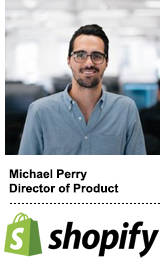
Shopify powers digital marketing for many of the savviest direct-to-consumer (DTC) brands.
In addition to its foundational ecommerce services, Shopify provides DTC marketers with a range of creative and media buying tools through an automated chatbot named Kit. It also connects merchants to major media platforms such as Instagram, Amazon, Google and Facebook through a single interface.
More than half of Shopify’s 800,000 merchants depend on its marketing tools to run their businesses, said Michael Perry, director of product at Shopify.
“Our mandate is to make marketing as simple as possible,” he said.
Although Shopify merchants rely on its connections into social platforms to reach their audiences and grow their businesses, Shopify believes entrepreneurs should control their customer relationships.
“The most important thing for entrepreneurs is to establish that direct relationship with their customers,” Perry said. “I have some concerns about that eroding away.”
He spoke with AdExchanger.
AdExchanger: How do you balance the relationship between platforms and DTC brands who want to own their data?
MICHAEL PERRY: Personally, I don’t know why anyone would want someone else to own their customer relationship. Unfortunately, that’s the exchange that takes place with a digital marketplace.
We want to build the right partnerships for our entrepreneurs managing these technologies, but we also owe it to them to establish a healthy relationship directly with their customer base. We’re trying to do all the things we can to help our entrepreneurs remain competitive.
We’ve been investing in the relationship with Facebook for some time, and we want our entrepreneurs to take advantage of that. We have those partnerships with Amazon, eBay and other marketplaces because we want to empower our merchants to sell everywhere. But our goal is to help them drive successful businesses. Keeping contact with your customers is at the heart of measuring the ROI of that.
How do you help DTC brands, especially solopreneurs, manage their marketing?
We remove the complexity to help get products out there as quickly and easily as possible. We have an ecosystem with thousands of apps that help our merchants with marketing. Part of the strength of Shopify is that ecosystem. We started with an online store but over time we’ve expanded into shipping, payments and sourcing. The lens of commerce has expended over time.
What is Kit?
Kit is an automated [chatbot] being used by 100,000 entrepreneurs. It handles and owns the marketing so they can focus on their customers.
Kit can do all of the marketing for a merchant’s product, [including] the copy and image [generation for] email marketing or social ads. Merchants can ask Kit to run a Facebook ad for their newest product, and Kit will optimize the budget to the highest ROI. Kit can make proactive suggestions about which products they should market on which platforms. A lot of entrepreneurs just don’t have the time, education or skill set to figure that stuff out.
Where are DTC brands buying the bulk of their media? Instagram? Stories?
Our merchants buy media across the board. We don’t do anything with Stories. We’re trying to figure that one out. If anything, Stories is a very authentic piece of the marketing puzzle, so we want to put our merchants in the driver’s seat.
We do social posting organically, Facebook single products and carousel ads, video ads, paid videos on Instagram and Google ads. And we turn to the app ecosystem to share products on Twitter, Pinterest or Snapchat. But our bread and butter is putting the product in front of the right audiences on the two largest media platforms in the word.
What kind of measurement solutions do you offer?
We don’t want our entrepreneurs to be wasting money, but we know attribution is hard to understand. So we have a bunch of user-friendly features. For example, we text our merchants and tell them exactly how their campaign did and [what] the process was if they want to use it again. We have very robust analytics to help them understand at a campaign level how marketing is performing. We have [an] events API that we’ve tied in with our marketing platform to map attribution as best as possible.
On an individual sales level, we talk about the customer journey, where the first touch was down to the last touch. We make it very clear what’s working and what’s not working. We’re trying our best to help them where they should be leaning in.
This interview has been edited and condensed.
This post was syndicated from Ad Exchanger.


More Stories
Meta’s Ad Business Is Still Surging As Headcount Ticks Upward
Island Gelato partners with Impact PR
Meta More Than Doubled Revenue From its AI-Powered Ad Tool